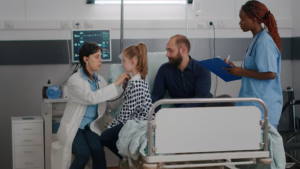Radiology Technologist in Allied Health: New Challenges & Opportunities
A radiology technologist is a leading innovator in healthcare, playing a vital role in diagnostic imaging. Meanwhile, pathologists are trained to accurately diagnose conditions and intervene effectively to enhance patient care across the healthcare continuum.
The job of radiology technologists is poised for revolutionary change as technology advances and the demand for healthcare increases. This article explores the future of this critical profession, including new technologies, new roles, and how to thrive in a changing world.
These trends shape the demand for colonoscopy and pressure on radiology technologists not only to meet but to lead in a new chapter of allied health.
Technological Innovations Transforming Radiology
Data Science and Artificial Intelligence Machine Learning
AI will transform the world of radiology — but not by replacing technologists; rather, it will work in a powerful partnership. Today, that train of AI algorithms is being put to use in improving image analysis, with programs accelerating the detection of anomalies in X-rays, CT scans, and MRIs like never before.
For technologists, this means moving from a world where image is derived and manipulated manually, towards a future of keeping an eye on AI, or deep-learning, based workflows. AI can, for instance, triage cases in emergency departments so technologists can tend to more complex processes or patients.
However, this shift necessitates competence in using AI tools and knowledge of their limitations. Technologists will need to validate AI outputs and ensure algorithms take into account rare conditions or patient-specific factors.
Advanced Imaging Modalities
Using multiplicative time images, we make 3D and 4D imaging with X-rays to evolve diagnostic precision. Cone-beam CT and spectral imaging are multi-dimensional techniques providing visualization from multiple dimensions and earlier disease detection in both cancer and cardiovascular disease types.
You should also be regularly trained to use these tools since the manufacturers are constantly updating the software and hardware. In addition, hybrid modalities—such as those combining positron emission tomography (PET) and magnetic resonance imaging (MRI) systems—integrate technical expertise with cross-training, including functional and anatomic imaging across several disciplines.
Imaging at the Point-of-Care and Portable Imaging
Handheld ultrasound units and mobile X-ray systems are among a host of portable devices that are decentralizing the delivery of imaging services. Radiology technologists now work in nontraditional settings, from rural clinics to sports arenas, delivering point-of-care diagnosis.
This sped up treatment decisions for critical situations, such as trauma or stroke care, but it does require flexibility. “Technologists have to balance factors like image quality with practical considerations, like space issues or patient mobility concerns.”
Transforming Role for Patient Care and Integration
Patient-Centered Care
Radiology technologists are moving from “image capturers” to holistic caregivers. Patients want a clearer understanding of procedures, risks, and outcomes.
Technologists have become a critical part of the education process around patients — for instance, about radiation safety during a CT scan or having their fears of claustrophobia addressed in MRI suites.
This opens the window of leveling these dialogues with empathy and people skills, facilitates rapport, builds trust, and helps in mystifying customers to comply.
Collaborating in Tandem with Other Fields
Radiologic findings have become a cornerstone of treatment plans due to data integrated into electronic health records (EHRs). They work with radiologists, surgeons, and oncologists and offer insights that inform therapies.
In tumor boards or in emergency triage teams, their perspective ensures that imaging supports clinical goals. This happens at the broadest level with AI developers up the food chain, where technologists submit real-world feedback about how algorithms can better support actual usage.
Specialization Opportunities
Such differences in sub-specialties (for example, interventional radiology (IR) or mammography) will also allow the radiologist opportunities for career advancement. IR technologists are also in the mix for minimally invasive procedures, including angioplasties or biopsies, bringing together imaging knowledge and surgical support. Like tomosynthesis, AI improves cancer detection for mammography. These niches demand more certifications but allow for greater independence and pay.
Education and Professional Development
The Need of the Hour is Continuous Learning
However, the pursuit of lifelong learning does have its pitfalls. As AI and new modalities spring, technologists must look ahead to have something concrete in the form of webinars, workshops, and certifications.
And although continuing education is a requirement for licensure from organizations such as the American Registry of Radiologic Technologists (ARRT), many will go beyond that and explore advanced concepts, such as AI ethics or hybrid imaging, to gain an edge over others in the field.
Hybrid Education Models
The pandemic sped up the acceptance of online learning, which now accommodates hands-on training. Technologists can practice occasional procedures, such as pediatric imaging, in no-risk virtual simulations. New fields are being credentialed for, and institutions are offering micro-credentials so technologists can upskill without interrupting their careers.
Certification and Regulation Changes
Certifications are also evolving with the tech. For example, the ARRT has included questions about AI and safety protocols for portable devices. Future credentials might center on data privacy or telehealth competencies and trends throughout health care.
Employment and Professional Prospects
Increasing Demand Due to Demographic Change
The aging population ensures continued need for imaging services. According to the Bureau of Labor Statistics, jobs in radiologic technology are projected to grow 6% from 2022 to 2032, faster than the average for all occupations. It will be driven by an increased demand for diagnostic and interventional procedures as a result of a higher burden of chronic conditions (osteoporosis, cancer).
Diverse Work Settings
Besides hospitals, technologists can also find jobs in outpatient surgery centers, academic institutions, and telehealth platforms. While teleradiology typically has a stigma of working only with radiologists, remote livescan technologists can also become active in the workflow by handling remote imaging or consulting with physicians who are not in the same area of the hospital as the projection.
The Rise of Travel Radiology
StaffDNA and other agencies are touting a travel radiology jobs boom. These jobs offer technologists good pay, flexibility, and the ability to work at various healthcare systems. Travel assignments also can relieve staffing shortages in under-resourced areas, marrying career advancement with a higher calling.
Challenges and Considerations
Fighting Burnout and Improving Wellness
Burnout is fueled by high patient volumes and technical pressures. An increasing number of employers are offering mental health resources, flexible work scheduling, and peer support programs. Technologists can alleviate some of that stress by setting boundaries or seeking work-life balance initiatives.
Ethical & Legal Implications of AI
AI enhances productivity yet pulls at the strings of ethics. Insufficient training data may lead to underdiagnoses of underrepresented groups. Technologists, in particular, can advocate for equitable AI tools and the implementation of stringent privacy protocols surrounding cloud-based imaging platforms.
The Journey Forward: And the Optimistic Take
We will enable the future of radiology technology. As the profession continues to evolve, in tandem with AI, portable tools, and patient-centered care, technologists will converge into a set of functions that marry technical wizardry with human touch. That gives you the hope of a western lifestyle via specialization and opportunities for travel while continuous study ensures that everything remains but faith in a tech-driven world.
Radiology technologists are not only witnesses to the future of healthcare — they are active architects. Innovative patient care focus and tools such as StaffDNA for career advancement and technologists will find their way through this new world. There will be difficulty along the road ahead, but also a great promise, the course is immaculate for those willing to change and lead the way.
Check out these other great Staffdna articles

Hospitalist Jobs vs. General Physician Assistant Jobs: What’s the Difference?
When medical professionals are considering their career options, the first things that come to mind are either hospitalists or general physician assistants.

Busting Myths About PRN Nursing Jobs: Pros, Cons & How to Find the Best Shifts
PRN nursing jobs have become a favorite among medical professionals looking for flexibility and higher pay. Yet, many misconceptions exist about PRN positions that scare some nurses away from considering it as a career choice.

How to Handle the Pressure of PACU Nursing Jobs Without Burning Out
Nursing is a demanding field, which becomes even more challenging when it comes to PACU nursing jobs.

How to Transition from Staff Nurse to A Travel Nurse
If you are a Registered Nurse with a strong desire to travel to different locations and save lives, you can be a travel nurse.

Travel Nursing: How to Choose the Best Career Assignments
Travel nursing is one way for nurses to work through new locations while also building their skill sets.

Understanding the PICU: A Guide for PICU Nurses
The pediatric intensive care unit (PICU) is a specialized department in hospitals and medical facilities. It is made to provide intensive care to infants, children, and adolescents with severe medical conditions.
